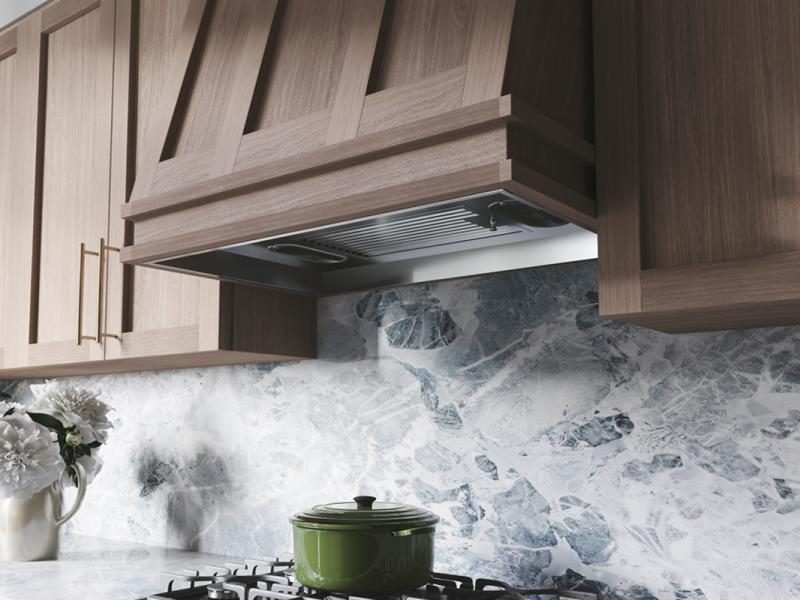What to Know About Streamlined Kitchen Vent

Cooking often leaves behind heat, odors, and smoke, which makes good airflow in the kitchen essential. While many homes include a standard range hood mounted above the stove, some kitchens may not come with one—especially in older houses, compact layouts, or spaces that rely on another ventilation system. In these cases, an insert vent hood can be a sleek, up-to-date solution. Understanding the benefits and drawbacks of this option can help you decide if it’s the right fit for your space.
What Is an Insert Vent Hood?
An insert vent hood—sometimes referred to as a cabinet insert or range hood insert—is a ventilation system designed to fit inside the cabinetry above your stove. Unlike a traditional hood, which comes as a complete standalone unit, an insert focuses only on the ventilation components and blends seamlessly into your kitchen design or a custom-built hood.
These inserts generally come in two forms:
- Ductless insert hood: Also known as a non-vented model, this option filters and recirculates the air back into the kitchen. It doesn’t need ductwork, making it suitable for almost any setup.
- Ducted insert hood: Also called a vented insert, this type pushes smoke, grease, and odors outdoors through ducts. While it’s more efficient, it can be expensive to install if your home isn’t already equipped with the necessary ducting.
Before moving forward, it’s wise to learn the advantages and disadvantages of each type, though a professional installer can also guide you toward the most practical choice for your kitchen.
| Pros of Insert Vent Hoods | Cons of Insert Vent Hoods |
| Good for small kitchens | Higher cost |
| Seamless appearance | Can be difficult to install and maintain |
| Customization | Ventilation can be limited |
Pros of Insert Vent Hoods
Insert vent hoods are often chosen for compact kitchens and for homeowners who prefer a clean, built-in appearance. Below are the key advantages.
1. Good for Small Kitchens
For kitchens where every inch counts, insert vent hoods offer a smart alternative. Unlike bulky traditional hoods that hang above the stove and reduce cabinet space, inserts are built directly into the cabinetry, creating a streamlined design while keeping the area above your cooktop more functional.
2. Seamless Look
Insert vent hoods stand out not just for function but also for style. Built directly into the cabinetry, they stay out of sight and contribute to a clean, polished appearance. SD Appliance Repair. This makes them a great choice for achieving a sleek modern layout or for refreshing an older kitchen while still preserving its original character.
3. Customization
Insert vent hoods provide more flexibility than standard models. Homeowners can select the dimensions, fan strength, and preferred filtration system. Many versions also include extras such as low-noise settings, built-in lights, and programmable timers for added convenience.
Cons of Insert Vent Hoods
While insert vent hoods are a common choice for compact kitchens, historic houses, and apartment settings, they do have disadvantages. These may include higher upfront expenses, possible challenges during installation, and in some cases, less effective airflow depending on the model and setup.
1. Higher Cost
Installing an insert vent hood is generally more expensive than putting in a standard range hood, since both the unit and the labor tend to cost more. The final price varies based on factors like brand, size, performance level, and added features. On average, installation falls between $1,040 and $1,540, which is typically a few hundred dollars higher than most other hood setups. A ductless insert model is often the budget-friendly choice, as it avoids the extra expense of adding ductwork.
2. Can Complicate Installation and Maintenance
Because insert range hoods are designed to fit directly into cabinetry, installation can be more complicated than with standard models. They’re usually manufactured in set sizes, which must align with the available cabinet space. Adding ductwork makes the process even more complex, though ducted systems only need periodic duct cleaning afterward. SD Appliance Repair. Ductless versions, on the other hand, call for a bit more upkeep since their filters need to be replaced regularly.
3. Limited Ventilation
How well an insert vent hood performs largely depends on the specific unit. Some models deliver stronger airflow than others, while ductless versions tend to be less efficient since they simply filter and recirculate the air instead of venting it outside.
Is an Insert Vent Hood Right for My Home?
Although having proper ventilation in a kitchen is important, it’s worth considering the advantages and limitations of different options. Insert vent hoods are a great choice for compact kitchens where a standard hood won’t fit, older homes without ductwork, or for those who prefer a more discreet look.
However, some kitchens simply don’t allow for a vent hood, or the layout makes installation tricky. In such cases, alternatives like wall-mounted hoods, island hoods, or under-cabinet units may be easier to implement. A professional installer can help you choose the right model and ensure it’s set up correctly for your space.
You Appliance Will Be Fixed!
in San Diego, CA
REQUEST SERVICE
Book a Repair Appointment

